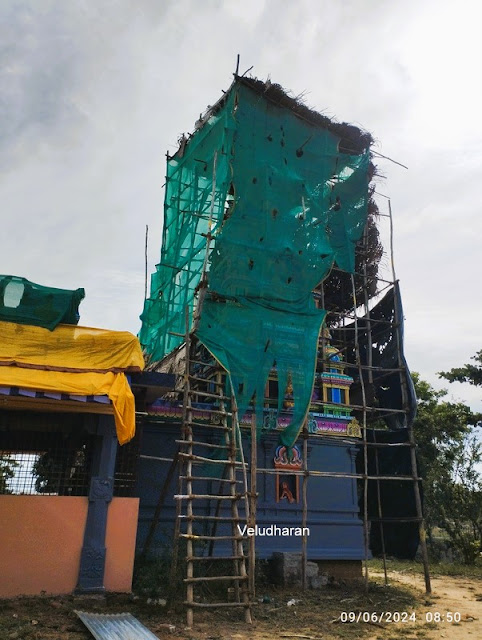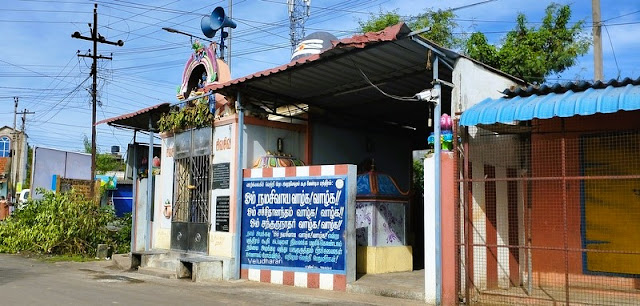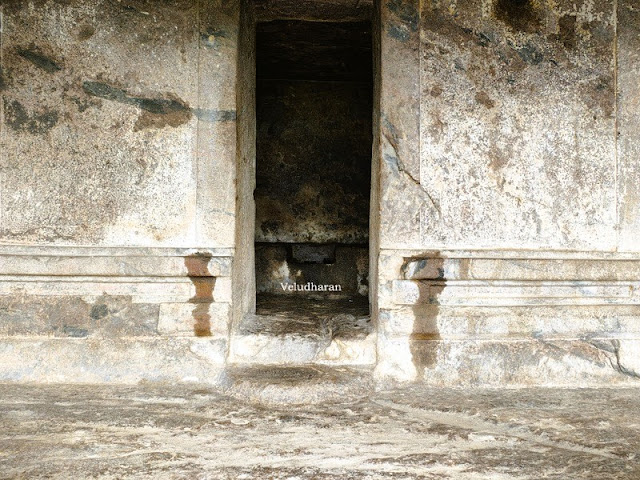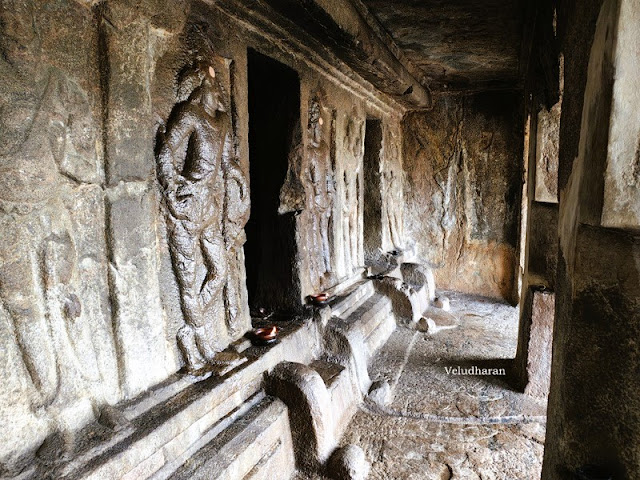There are four rock-cut caves in the Mamandur hills, ( also called Narasamangalam Rock cut Caves, and Mamandur as Dusi Mamandur ), of which two caves were used as shrines with Pallava and Chozha Period inscriptions. The whole site is maintained by the Archaeological Survey of India (ASI). The details of the two rock-cut cave temples are as follows. The other two were only mandapams with no specific importance.
THE CAVE NO - 1.
The north-end rock-cut cave temple is facing east. This rock-cut temple consists of a front mandapam with two rows of pillars. The cave consists of 3 cells, ardha mandapam and a mukha mandapam. The pillars are massive squares at the base & top, and octagonal in the middle, and carry heavy corbels. Lotus medallions are on the Pillars. The pilasters at either end are square from base to top. The Shrines, adhistanam is chiseled as pada bandha adhistanam, with jagathy, threepatta Kumudam and Pattikai. Flight of three steps from the Mandapa leads to the simple shrine entrance, such shrines are guarded by a pair of Dwarapalakas or the doorkeepers typical of the deity enshrined. In the shrines, holes are provided to install the idols.


( Pillars with Pothiyals on the same rock)
INSCRIPTIONS
This rock-cut cave has Pallava and Chozha period inscriptions. The Chozha period inscriptions are not in readable condition.
From the Pallava King Mahendra Varman has written the drama Mattavilasa Prahasana. The inscription also records his other titles as “Sathru Mallan”, "Nithya Virthan", “Sathya Saanthan", etc. This inscription was inscribed during Mahendra Varman -1 ( 600 – 630 CE ).
Mahendra
Varman-I’s period, a much-damaged 17-line Pallava Grantha inscription on the northern
wall of the Mukha mandapa, records important details of Mahendra Varman-I. The inscription
mentions the King’s titles as Satrumalla, Nityavinita, and Satyasandha, and the
expressions such as Panchalanirmita, Valmikivanita, Vatsapahara, Vyasapahara,
Vyasakalpa, Kavinamprakasha, Vrittidakshinachitra and Varnachaturttha.
As
per the experts, the Gandharva sastra mentioned in the first line refers to a
Musical Book. The 9th line; records the musical notes, which can be
brought in Veena. This shows the King’s interest in music. The
word வர்ண சதுர்த – mentioned in the 12th line refers
to drawing, which may call himself as Chitrakarapuli. The Poets Valmiki, 3rd
line, and Viyasa, in the 6th line, mentioned, show the King’s
interest in Literature. As per the experts, from the words மத்தவிலாச பிரகசனம் & பகவதஜ்ஜுனம்,
mentioned in the inscription indicates that
the king might have been written the மத்தவிலாச
பிரகசனம், a drama criticizes
the other religions. The 16th and 17th lines indicate him
as a Devotee of Maha Vishnu. Hence the experts believe that this
cave might have been excavated for Maha Vishnu comparing the Mahendravadi, a monolithic
Rock Cut Cave.
Ref:
1. Topographical List of inscriptions of Tamil Nadu and Kerala Volume-1.
2. South Indian Inscriptions Volume -IV, Sl Nos 136, 137 and 138.
3. தமிழியல் ஆய்வுச் சிந்தனைகள் தொல்லியல் வரலாறு & சமூகவியல், by Se. Jeen Lawrence and Ku. Bhagavathy.




THE CAVE NO -2, RUDRA VALISWARAM.
This cave is called Rudra Valisawaram cave temple. The cave consists of 3 cells, ardha mandapam and a mukha mandapam. This rock-cut temple consists of a front mandapam with two rows of pillars. The pillars are massive square at the base & top and octagonal in the middle and carry heavy corbels. The pilasters at either end are square from base to top. Flight of three steps from the Mandapa leads to the simple shrine entrance, such shrines are guarded by a pair of Dwarapalakas or the doorkeepers typical of the deity enshrined. The Shrines, adhistanam is chiseled as pada bandha adhistanam, with jagathy, threepatta Kumudam and Pattikai. A Shiva Lingam is found in the middle of the three shrines. The Shiva lingam was installed on a square avudayar. The other two Shrines are empty and Dwarapalakas are at the entrance.
There are two Chozha inscriptions of the time Utama Chozha and Rajaraja called this cave as Viruttiravaliswaram and Valiswaram respectively and mention the Chitramegha tataka, a large Pallava irrigation tank. No Pallava inscription exists, but stylistically the cave is attributed to Mahendra Varma Pallava – 1 ( 600 – 630 CE ).
The
Chola king Parakesarivarman’s (maybe Uttama Chola ), 15th reign
year inscription behind the southernmost pilaster on the southern wall of the
ardha mandapa, Records a gift of ewes for burning half a lamp during daytime, to the temple Narasingamangalathu Valiswaram, near the tank Chittiramegha Thadaga, by Two persons, each sponsoring 1/4 lamps. They are Nattadiyan son of Adhipusangachchetti, a merchant of Tiruvanamalai
situated on the northern bank of Pennai, in Vanakappadi, and Satthakutti Viran, a manradi ( shepherd ). They had gifted 45 1/2, saava moova peradu/ewes.
The
Chola king Rajarajakesarivarman’s ( Rajaraja – I ), 16th reign year
( 1001 CE ), inscription on the northern side wall of the mandapam starts with his Meikeerthi, Records the
gift of 46 sheep to the temple of Rudravalisvara Mahadeva at Narasimhamangalam
in Uttamachola Isvarapuram of Tiru Ekambam to the east of the Chittiramegha Thadaka
in Kaaliyurkkottam, for burning half a lamp. The donor was
Thiyangudaiyan Ampaniraman ( தீயங்குடையான் அம்பனிராமன் ).
Ref:
1. Topographical
List of inscriptions of Tamil Nadu and Kerala Volume-1.
2. South Indian Inscriptions Volume -IV, Sl Nos 136, 137 and 138.
3. தமிழியல் ஆய்வுச் சிந்தனைகள்
தொல்லியல் வரலாறு &
சமூகவியல், by Se. Jeen Lawrence and Ku. Bhagavathy.

ROCK-CUT CAVE No. 3.
This
is comparatively a large Rock Cut Cave, to other Caves. This Cave is excavated
with 6 Cells ( 4 cells + 2 side cells ). In addition, 3 cells are also
excavated. The Rock Cut Cave consists of 6 shrines, ardha mandapam and mukha
mandapam. The ardha mandapam and mukha mandapams are supported by 9 Pillars
with Tharanga pothyals. The cave seems
to be unfinished.
ROCK CUT CAVE No. 4.
This rock-cut cave consists of only a mandapa, supported by two pillars and two pilasters
with Tharanga pothiyal. One cell is marked and excavation was started and
stopped unfinished.
Excavation Chisel marks
JAIN BED IN NATURAL CAVE AND THAMIZHI / BRAHMI INSCRIPTIONS
There is also a natural cave with a stone bed in which there is an early 2nd 3rd century CE Tamil Brahmi inscriptions found on the rock. There are no proper steps to reach this natural cave.
INSCRIPTION
As
per the Topographical List of Inscriptions of Tamil Nadu and Kerala States
Volume-I, Thamizhi / Tamil Brahmi characters, dateable to the 2nd -3rd
century CE – seem to record that this
cavern was the gift of a certain chief (name not clear) who captured Torur and
was the work of a mason (?) called Chalavani. As per Mahadevan, “(the) hill
(of) Kan-man, (the) chieftain (who) took Tenur; Ciru…van, stone mason, made
(this)”
( Brahmi letters on the rock )
The way to reach the cave
--- OM SHIVAYA NAMA ---























































